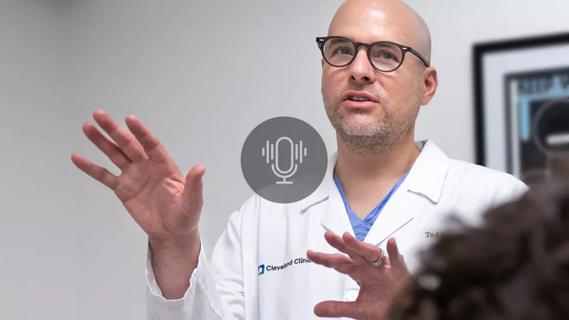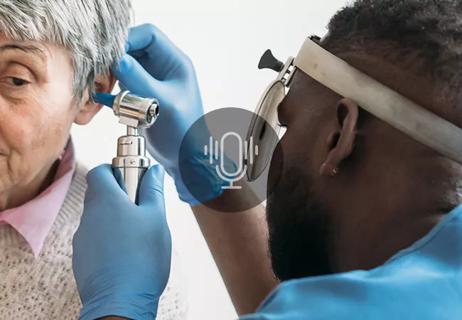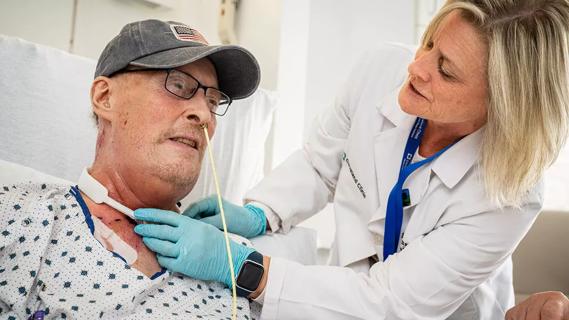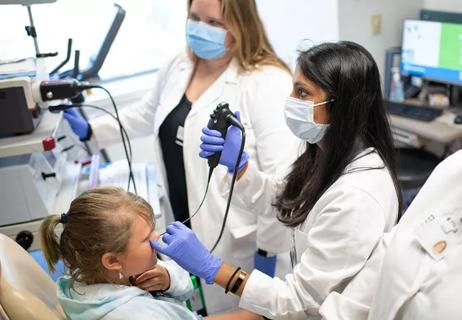Advertisement
An innovative approach to improving quality of life

By Julie Honaker, PhD, and Amy Johnson, CNP
Advertisement
Cleveland Clinic is a non-profit academic medical center. Advertising on our site helps support our mission. We do not endorse non-Cleveland Clinic products or services. Policy
Symptoms of dizziness – including vertigo and imbalance – are estimated to affect upwards of 20 percent of adults per year, with an increase in prevalence with advanced age (Neuhauser, 2016). These symptoms are commonly linked to inner ear vestibular disorders, including Benign Paroxysmal Positional Vertigo (BPPV), vestibular migraine and Meniere’s disease. However, there are numerous other causes that must be ruled out, including medication effects and cardiovascular, neurological and even psychological disorders. Even healthy individuals may report symptoms of imbalance, which can be secondary to the aging process.
It stands to reason that dizziness is one of the most common causes for doctor visits and hospital admissions. Patients with these symptoms have significant activity restrictions and reduced quality of life. The restriction of physical activity then leads to decreased physical conditioning and balance skills and can increase the likelihood of future falls. To stop this vicious cycle and reduce falling risk, early evaluation and management of patients with dizziness and imbalance are essential.
Often the complexities of dizziness are difficult to determine at individual medical provider appointments due to the multifaceted reasons and potential causes. Access to one-on-one appointments with specialists also presents a challenge. Patients with chronic disease (including dizziness) benefit from additional education and encouragement to remain healthy and break the cycle restricting activities and participation. For these reasons, the use of a shared medical appointment (SMA) may provide a more efficient solution to standard care by having patients with similar symptoms and disorders benefit from a longer appointment session with multiple providers and group education (Coates et al. 2017; Bartley, 2010).
Shared medical appointments are not a new concept, and have been in existence since the late 1990s (Bartley, 2010). This type of appointment is unique in that it provides simultaneous one-on-one patient encounters in a group setting. An SMA is now offered to all prospective new patients to the Cleveland Clinic Head & Neck Institute who report symptoms of dizziness and imbalance.
Patients with interest in a group setting are most favorable for this type of appointment. Patients may be of any age, gender or background – with acute or chronic illness. The appointment team includes:
While this is a group appointment, each patient is addressed individually during case history and system review, and receives a private otology examination away from the group setting.
This model can improve patient access, with shorter wait times and coordination of appointments (Kaider-Person et al, 2006). SMAs are cost effective and can also increase physician productivity (Seesing, 2015). Patients feel empowered to communicate information and motivated to follow the plan of care (Coates et al. 2017). Overall, patients who have participated in the Cleveland Clinic Dizziness SMA found it to be valuable and appreciated learning that they are not alone with symptoms of dizziness and imbalance.
Advertisement
We have found that this model truly represents a team-based approach to the management and care of patients with dizziness and imbalance complaints, and it is our hope that it will continue to improve healthcare delivery for better patient satisfaction and engagement, reduced wait times and improved quality of life for patients (Ramdas & Darzi, 2016).
Dr. Honaker is Director of Vestibular and Balance Disorders Laboratories at Cleveland Clinic; she can be reached at honakej@ccf.org. Amy Johnson, CNP, is a certified nurse practitioner in the Head & Neck Institute.
References
Bartley, K.B., & Haney, R. (2010). Shared medical appointments. Improving access, outcomes and satisfaction for patients with chronic cardiac disease. J Cardiovasc Nurs, 25(1), 13-19. doi: 10.1097/JCN.0b013e3181b8e82e.
Coates, J., Gething, F., & Johnson, M.I. (2017). Shared medical appointments for managing pain in primary care settings? Pain Manag, 7(4), 223-227. doi: 10.2217/pmt-2017-0016.
Kaider-Person, O., Swartz, E.W., Lefkowitz, M., Rosenthal, R. (2006) Shared medical appointments: new concept for high-volume follow-up for bariatric patients. Surg Obes Relat Dis, 2, 509-512.
Neuhauser, H.K. (2016). Chapter 5 – the epidemiology of dizziness and vertigo. Handbook of Clinical Neurology, 137, 67-82. Doi: 10.1016/B978-0-444-63437-5.00005-4.
Ramdas, K., & Darzi, A. (2016). Adopting innovations in care delivery – the case of shared medical appointments. N Engl J Med, 376(12), 1105-1107. doi: 10.1056/NEJMp1612803.
Seesing, FM, Groenewould, HJ, Drost, G., van Engelen, B.G., & van der Wilt, G.J. (2015) Cost-effectiveness of shared medical appointments for neuromuscular patients. Neurology, 85(7), 619-625. doi: 10.1212/WNL.0000000000001857.
Advertisement
Advertisement

A multidisciplinary approach and individualized plan of care are imperative

Insight on larynx disorders and treatments

Novel procedures provide options for patients who can’t tolerate CPAP

Research on children with UHL explores the quality-of-life benefits and outcomes of cochlear implants

A look at how custom-fitted oral appliances work and when they’re a good fit for patients

Hearing loss and its treatments are often misunderstood by both the public and healthcare professionals

Modified Barium Swallow Study and Flexible Endoscopic Evaluation of Swallowing can both be used to diagnose dysphagia, but it’s important to understand their advantages and disadvantages

By working in tandem, a pediatric otolaryngologist and speech-language pathologist can diagnose conditions and develop treatment plans in the same visit